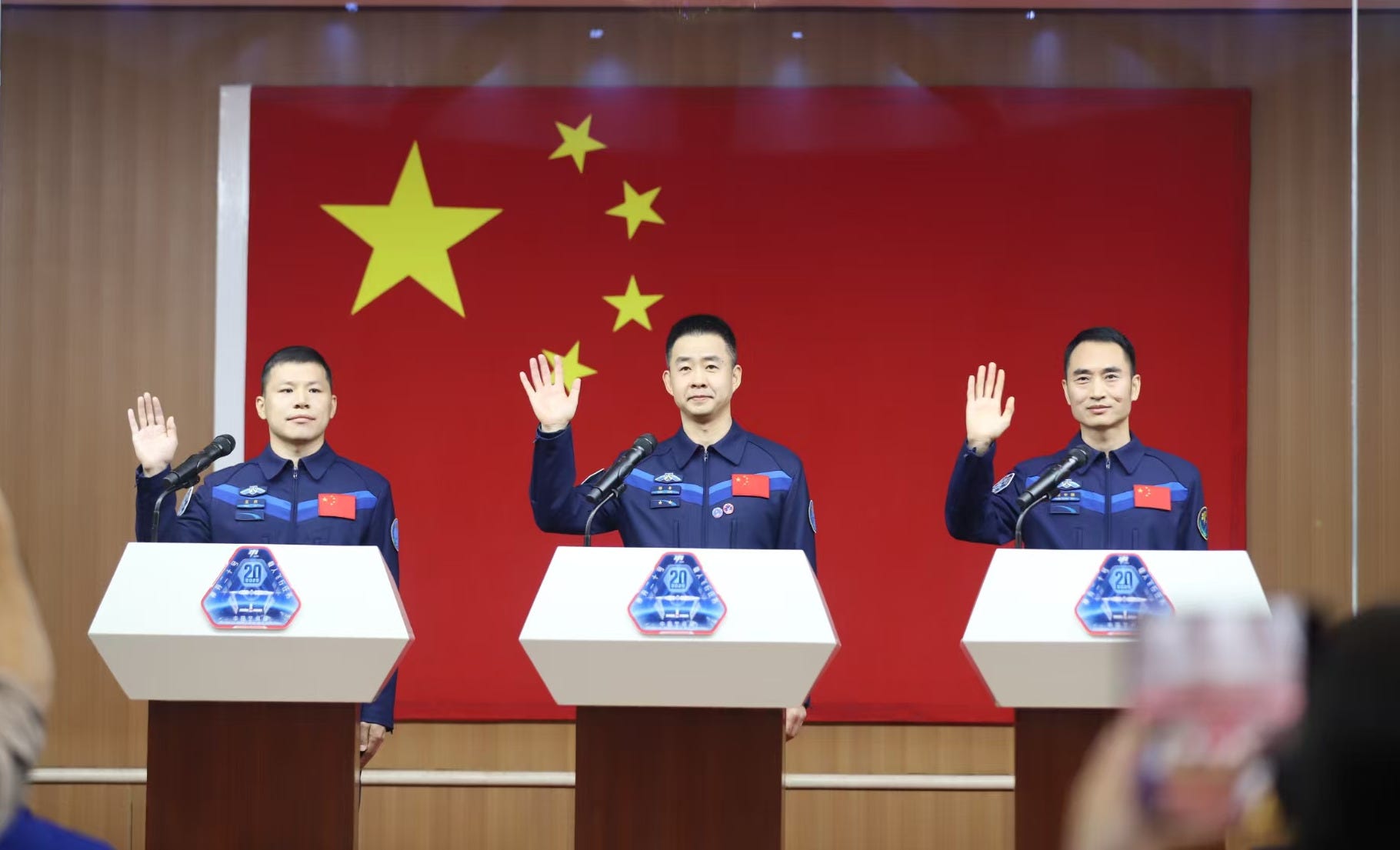
The Shenzhou-20 mission is just over a day away from launch, and earlier today, the China Manned Space Agency held its regular two press conferences prior to launch. Up first, agency officials briefed the media on the mission, with the three taikonauts speaking to the press afterwards.
Beginning the conference, it was announced that Chen Dong (陈冬), born in 1978, is Shenzhou-20’s mission Commander, having flown the Shenzhou-11 and Shenzhou-14 missions previously for 214 days spent in space. The mission Operator was announced to be Chen Zhongrui (陈中瑞), born in 1984, from the third taikonaut batch, for his first spaceflight. Wang Jie (王杰), born in 1989, was revealed to be the missions Science Operator, also being from the third batch for his first flight. Before selection, Chen Zhongrui was a pilot in the People’s Liberation Army Air Force while Wang Jie was an engineer from the China Aerospace Science and Technology Corporation.
Following the announcement of the crew, the launch date and time were revealed to be April 24th at 17:17 pm China Standard Time, or 09:17 am Universal Coordinated Time, with docking to the Tiangong Space Station set for around six and a half hours after launch. A return to Earth to end the mission was said to be set for late October this year. Onboard the station for six months, the crew is planned to perform science experiments, spacewalks for station maintenance, and science popularization events.
On the return of Shenzhou-19, it was stated that the crew, consisting of Cai Xuzhe (蔡旭哲), Song Lingdong (宋令东), and Wang Haoze (王浩泽), would return to Earth on April 29th. Before that, a handover ceremony between the two crews would take place onboard the station.
Starting to take questions from the press, it was highlighted that Shenzhou-20 would launch on the fifty-fifth anniversary of the Dongfanghong-1 satellite, China’s first satellite. The choice of launching the mission on this date was explained to be based on technical needs to reach the station, making it the optimal choice, with the space station able to save some propellant too.
For a question regarding the work of the Shenzhou-19 crew, it was noted that so far, the three crew members had been in space for 175 days, and completed three spacewalks, including a world record one for its duration, as well as fixing a payload adapter that jammed during installation. Various science experiments in the fields of quantum research, life sciences, and plant biology were conducted too. Several samples from research conducted onboard will be returning with the crew.
Regarding the new fourth batch of taikonauts, the agency revealed that individuals selected from the Hong Kong and Macau Special Administrative Regions will start flying in 2026. Additionally, it was shared that two astronauts from Pakistan are expected to begin training soon before heading to the station as a payload specialist. Other unnamed countries were said to be interested in sending astronauts to Tiangong as well.
One of the most anticipated questions put forward during the conference was regarding progress on China’s crewed lunar exploration program. The China Manned Space Agency shared that progress on the Long March 10 Moon rocket, Mengzhou crew capsule, Lanyue lunar lander, Wangyu spacesuit, and Tansuo lunar rover is moving smoothly. In support of landing missions, a lunar remote sensing satellite constellation is underway too. Tests performed so far on lunar hardware are electrical systems tests for the Long March 10, high-altitude drop tests of the Mengzhou capsule, and thermal tests of the Lanyue lander. Further tests planned are an abort test of Mengzhou, landing verification tests of Lanyue, static fires and a low-altitude hop of the Long March 10, and an in-flight abort test with Mengzhou. These tests are expected to occur at the Wenchang Space Launch Site and the Jiuquan Satellite Launch Center.
Folllowing a press conference with China Manned Space Agency officials, the Shenzhou-20 crew, Chen Dong, Chen Zhongrui, and Wang Jie, took questions from the press.
Chen Dong was asked what differences there are for this mission, as he is commanding this flight for his third overall. Chen responded that it was an honor, and he hopes to make more scientific breakthroughs onboard the station as well as to cultivate the experience of his crewmates, who are first-time flyers.
Chen Zhongrui was asked about how his experience as a pilot led him to the mission, he responded that he is proud to serve on board the station shortly, having been selected as one of eighteen taikonauts from the third batch.
Wang Jie was asked what it is like to be a taikonaut from the Inner Mongolia region, he said that he was inspired by Yang Liwei’s Shenzhou-5 mission which landed in his home region, leading him to become and aerospace engineer and later a taikonaut.
Regarding how the crew expects to work together, mission Commander Chen Dong stated that he expects their skills to mesh well, having known his crewmates for many months in the lead-up to launch. With extensive pre-flight training, Chen is confident that the crew will successfully complete the mission. Chen Zhongrui added him and Wang Jie were initially nervous when meeting Chen Dong, but have since grown into a strong team. Additionally, Wang Jie stated that despite having different responsibilities onboard Tiangong, they are each others backups and are prepared to assist one another.
In a final question regarding the 10th Space Day and fifty-fifth anniversary of Dongfanghong-1, Chen Dong was asked what his feelings on the event were. He responded that he and his team will endeavor to successfully complete the Shenzhou-20 mission to carry forward China’s space dreams, which began fifty-five years ago.




